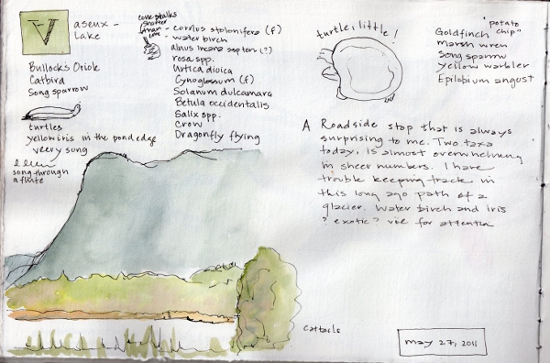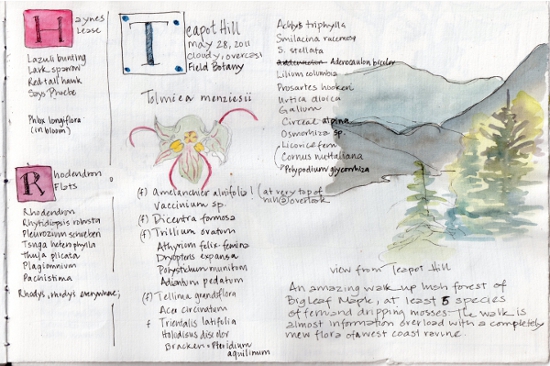After 3 weeks in Kamloops, the combined classes of Field Botany and Field Ornithology from TRU embarked on a whirlwind tour of the plant and bird life of southwestern BC. As part of Field Botany, I asked students to keep a field journal (notebook) of the landscapes and plants that we encounter. These journals are often the best things I have to mark in my life as an academic naturalist. I spent the last two days pouring over my students field journals and it seems only fair that my sketches and scrawls are similarly viewed.
Our trip took us from the lush coniferous forest (Fritillaria lanceolata in full bloom!) along the north side of Adams River into the drier landscapes of British Columbia’s Okanagan Valley. At the end of a long rainy day, the clouds lifted just as we pulled into our campsite at Fintry Provincial Park. The next day, White Lake Protected Area harbored blooming bitterroots on the ridge that looms over the saline waters of the lake. After leaving the arid zone of the South Okanagan, we went up and over Manning Park and descended into the lush maple forest surrounding Cultus Lake. Teapot Hill was an extravaganza of Saxifragaceae and Liliaceae. The abundance of both plants and birds at Reifel Wildlife Refuge was in stark contrast to the surrounding suburbia of Greater Vancouver. Our last major stop was amidst the forests of Golden Ears where bryophytes loom large in their sheer expansiveness, covering seeming every stable surface. Old forests, and after spending four summers sampling their abundance in coastal western hemlock forests, I said their names aloud to the students, relishing the familiarity of these old friends.
Excerpts from my Field Journal during the Field Botany Finale:
Fintry Provincial Park
Up Short Creek Canyon at Fintry

The view from the bitterroot ridge at White Lake

White Lake botany

Vaseux Lake

Hayne’s Lease to Teapot Hill

Reifel Wildlife Refuge


Gold Creek at Golden Ears Provincial Park














